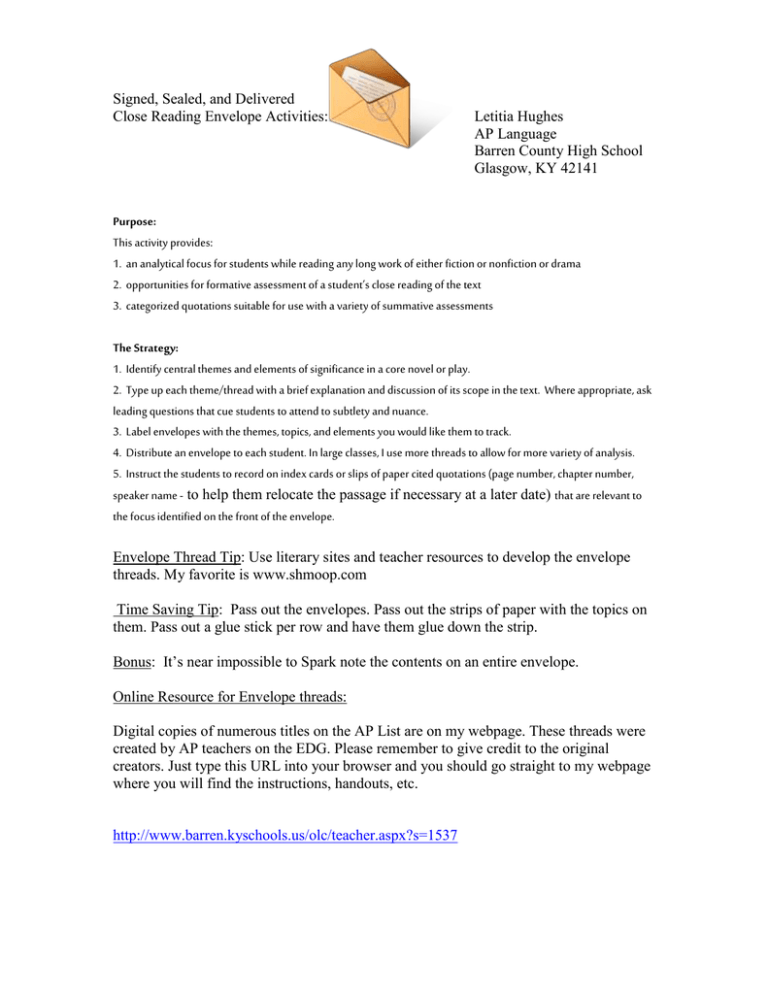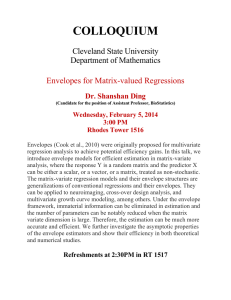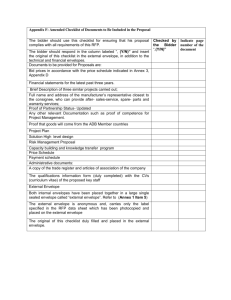AP Language Close Reading Envelope Activities
advertisement

Signed, Sealed, and Delivered Close Reading Envelope Activities: Letitia Hughes AP Language Barren County High School Glasgow, KY 42141 Purpose: This activity provides: 1. an analytical focus for students while reading any long work of either fiction or nonfiction or drama 2. opportunities for formative assessment of a student’s close reading of the text 3. categorized quotations suitable for use with a variety of summative assessments The Strategy: 1. Identify central themes and elements of significance in a core novel or play. 2. Type up each theme/thread with a brief explanation and discussion of its scope in the text. Where appropriate, ask leading questions that cue students to attend to subtlety and nuance. 3. Label envelopes with the themes, topics, and elements you would like them to track. 4. Distribute an envelope to each student. In large classes, I use more threads to allow for more variety of analysis. 5. Instruct the students to record on index cards or slips of paper cited quotations (page number, chapter number, speaker name - to help them relocate the passage if necessary at a later date) that are relevant to the focus identified on the front of the envelope. Envelope Thread Tip: Use literary sites and teacher resources to develop the envelope threads. My favorite is www.shmoop.com Time Saving Tip: Pass out the envelopes. Pass out the strips of paper with the topics on them. Pass out a glue stick per row and have them glue down the strip. Bonus: It’s near impossible to Spark note the contents on an entire envelope. Online Resource for Envelope threads: Digital copies of numerous titles on the AP List are on my webpage. These threads were created by AP teachers on the EDG. Please remember to give credit to the original creators. Just type this URL into your browser and you should go straight to my webpage where you will find the instructions, handouts, etc. http://www.barren.kyschools.us/olc/teacher.aspx?s=1537 Titles Available: 1984 Alias Grace A Midsummer’s Night Dream A Thousand Splendid Suns All Quiet on the Western Front Angela’s Ashes As I Lay Dying Atonement Black Boy Brave New World Catcher in the Rye Death of a Salesman Ethan Frome Frankenstein Grapes of Wrath Hamlet Handmaid’s Tale Heart of Darkness Huck Finn Jane Eyre King Lear Lesson before Dying Light in August Lord of the Flies Macbeth Madame Bovary Malcolm X Night Of Mice and Men Pride and Prejudice Sea biscuit Season of Migration to the North Tartuffe The Awakening The Book Thief The Canterbury Tales The Chosen The Crucible The Great Gatsby The Hobbit The Jungle The Kite Runner The Odyssey The Picture of Dorian Gray The Road The Scarlet Letter The Visit Their Eyes were Watching God Things Fall Apart To Kill a Mockingbird Wuthering Heights Some Opportunities for Formative Assessment: Options for envelope thread activities: 1. Allow students to use the contents of their or another student’s (take them up and redistribute them) envelope to guide a Socratic Seminar. 2. Simply count the number of quotations in the envelope at various intervals to gauge if reading is happening. The kinds of quotations will also be quite telling about the depth of thought the student is bringing to his or her reading. Formative feedback can be offered about the need to find passages that probe the idea of the prompt, rather than just containing general references to the envelope topic. 3. Put students in groups, (either all students with the same envelope focus or in a mixed group,) and have them share the quotations they have chosen. Have the students justify their choices. Provide feedback about depth and relevance. Allow the quotations to suggest group and class discussion about the novel. 4. Put kids with the same topic together have them synthesize what they have done and develop seminar-type questions and then lead a discussion on their topic first in their small groups and then with the whole class. 5. “Butcher Paper Essays”: After students have completed reading the entire novel, put them into groups of the same envelope topic. Then, as a group have them create a meaningful thesis statement about that topic and write it across the top of a piece of butcher paper. Then have students categorize the quotes from the envelopes in order to support that thesis in multiple ways. Once they have some "categories" and set aside duplicates, they can create a claim (topic sentence) that supports the thesis , write it on the butcher paper, and then tape/glue the slips of paper that support each of those topic sentences onto the butcher paper below the topic sentence as data. Next have students analyze how the data (slips of paper) supports the claim that supports the thesis; I call this warrant, others call it commentary. You will up with giant "outlines" of meaningful analysis in a essay form on butcher paper. There will be an interesting variance in the data strips glued / taped onto the butcher paper from all the envelopes. As some students may have written on different colors of paper, post it notes, index cards, some may be neatly typed and cut apart precisely, some may be on paper torn apart unevenly. The finished product will be as diverse as the students in your class. 6. As a quiz grade, “Open your envelope, select X number of passages and write an analysis of the passages. 7. As a quiz grade…. I take up envelopes and pass them back out to kids ensuring they have a new topic and …. “Open your classmate’s envelope, select X number of passages and write an analysis of each of the passages” Then return it to original owner. 8. Use quotations from the envelope to generate formative quotation analysis-style quizzes. 9. Group discussions – my classes are often too big for truly effective Socratic (34 kids). Some days are like above and meet with same topic, other days we meet with different topics in a group and some are jigsaw days where we do both. Then we share best discussion concepts with whole class. 10. Analysis of syntax and diction in a passage on smart board. We alternate between envelopes and analyze a passage as a class on the smart board. Ex: While reading To Kill a Mockingbird, I selected a student’s envelope and then the passage about the cemetery beside Cal’s church. The description of the tombstones, graves, etc. is long and involved but the last sentence says “It was a happy cemetery.” We analyzed the paradox and syntax. This set the precedence for students to pick a passage on certain days and type it up to show on the smart board and lead the class in the analysis of the passage. 11. Sometimes they trade envelopes after X number of chapters and track something new, sometimes they keep the same topic through the whole novel. 12. Write an in class timed essay on the topic on your envelope. You can use the passages in your envelope as your data / evidence (Claim, data/evidence, warrant/insight structure). 13. Have the students, (either individually or in groups,) present the quotations to the class. This provides opportunities for formative feedback about presentation skills. You could have the students practice incorporating media into a presentation by having the students integrate a thematically related film or audio clip into their presentation, or you could ask them to prepare two to three Power Point slides to assist them as they explain their chosen passages. Ex: The Crucible Logical Fallacy presentations 14. Use them as summer reading assignments. I tried this with The Great Gatsby last year. We did many of the activities above over the course of the first few days of school. The students showed up the first day of school with envelopes brimming with prime excerpts from the novel already grouped thematically. The beginning of the year began fluidly with higher level analysis. At the end of the previous school year, I just went to the pre-AP courses and handed the assignment and the envelopes to my future students. Reflection: Jot down any ideas you have now about how the envelopes can be used….. Share with the group!!!!! Example of using the envelopes for close reading…. While reading TKAM, envelope groups met who have the same topic to share their passages selected from the first 8 chapters. The group who had feminism was discussing a passage that a student chose to include in her envelope and the other three had not. Her passage was about when Dill, Jem and Scout “play” the Radleys- that all Scout gets to do is come out and sweep the porch as Mrs. Radley. I heard a girl say that Scout’s sweeping the porch reflects the role of women as in that Mrs. Radley had no real say in whether Arthur was sent to the reform school like the rest of his friends who put the beadle in the outhouse or whether he was kept at home as her husband insisted. This is extended when her husband dies and Nathan moves in to pick up where his father left off. She said, “You would think she would say ‘You’re free Boo!’ when her husband died but Nathan is in control now and does things like plug up the tree hole.” She also added that men carrying on the mission of their father whether they agreed with it or not is part of that Southern culture and caste system. I never even thought of that so we used it as a whole class discussion springboard. Mrs. Radley dies in chap. 8, leaving them to wonder Boo’s fate. We discussed whose prisoner is Boo Radley really. We even came back to this in our whole class discussion at the end of the novel when another student had a quote from Jem about how Boo doesn’t want to come out. In conclusion….. Of course, I love envelopes because it is the best thing I have done since I began teaching AP. In my first year teaching AP- before I began using envelopes the students were too focused on plot analysis; envelope threads are the single factor that moved my students to close reading rhetorical analysis. Common Core Standards addressed by The Envelope Strategy Grades 9-10 Literature Key Ideas and Details RL.9-10.1. Cite strong and thorough textual evidence to support analysis of what the text says explicitly as well as inferences drawn from the text. RL.9-10.2. Determine a theme or central idea of a text and analyze in detail its development over the course of the text, including how it emerges and is shaped and refined by specific details; provide an objective summary of the text. RL.9-10.3. Analyze how complex characters (e.g., those with multiple or conflicting motivations) develop over the course of a text, interact with other characters, and advance the plot or develop the theme. Grades 9-10 Informational Text Key Ideas and Details RI.9-10.1. Cite strong and thorough textual evidence to support analysis of what the text says explicitly as well as inferences drawn from the text. RI.9-10.2. Determine a central idea of a text and analyze its development over the course of the text, including how it emerges and is shaped and refined by specific details; provide an objective summary of the text. RI.9-10.3. Analyze how the author unfolds an analysis or series of ideas or events, including the order in which the points are made, how they are introduced and developed, and the connections that are drawn between them Grades 11-12 Literature Key Ideas and Details RL.11-12.1. Cite strong and thorough textual evidence to support analysis of what the text says explicitly as well as inferences drawn from the text, including determining where the text leaves matters uncertain. RL.11-12.2. Determine two or more themes or central ideas of a text and analyze their development over the course of the text, including how they interact and build on one another to produce a complex account; provide an objective summary of the text. RL.11-12.3. Analyze the impact of the author’s choices regarding how to develop and relate elements of a story or drama (e.g., where a story is set, how the action is ordered, how the characters are introduced and developed). Grades 11-12 Informational Text Key Ideas and Details RI.11-12.1. Cite strong and thorough textual evidence to support analysis of what the text says explicitly as well as inferences drawn from the text, including determining where the text leaves matters uncertain. RI.11-12.2. Determine two or more central ideas of a text and analyze their development over the course of the text, including how they interact and build on one another to provide a complex analysis; provide an objective summary of the text. RI.11-12.3. Analyze a complex set of ideas or sequence of events and explain how specific individuals, ideas, or events interact and develop over the course of the text. Grades 9-10 Writing Text Type and Purposes WHST.9-10.2. Write informative/explanatory texts, including the narration of historical events, scientific procedures/ experiments, or technical processes. o Introduce a topic and organize ideas, concepts, and information to make important connections and distinctions; include formatting (e.g., headings), graphics (e.g., figures, tables), and multimedia when useful to aiding comprehension. o Develop the topic with well-chosen, relevant, and sufficient facts, extended definitions, concrete details, quotations, or other information and examples appropriate to the audience’s knowledge of the topic. Grades 11-12 Writing Text Type and Purposes WHST.11-12.2. Write informative/explanatory texts, including the narration of historical events, scientific procedures/ experiments, or technical processes. o Introduce a topic and organize complex ideas, concepts, and information so that each new element builds on that which precedes it to create a unified whole; include formatting (e.g., headings), graphics (e.g., figures, tables), and multimedia when useful to aiding comprehension. o Develop the topic thoroughly by selecting the most significant and relevant facts, extended definitions, concrete details, quotations, or other information and examples appropriate to the audience’s knowledge of the topic.


